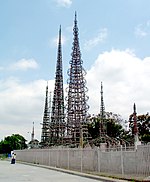Imperial Courts
Los Angeles building and structure stubsPublic housing in Los AngelesResidential buildings completed in 1944Watts, Los Angeles

Imperial Courts is a public housing project located in Watts, Los Angeles, California. It is located at 11541 Croesus Avenue on Imperial Highway, between Grape Street and Mona Boulevard, near the 105 Freeway. The federally subsidized project of 498 units was completed in May 1944. It is operated by the Housing Authority of the City of Los Angeles. The project is predominantly inhabited by persons of African-American and Mexican descent, who in 1991 constituted 88 percent of the population. It is one of the largest housing projects west of the Mississippi.
Excerpt from the Wikipedia article Imperial Courts (License: CC BY-SA 3.0, Authors, Images).Imperial Courts
Gorman Avenue, Los Angeles Watts
Geographical coordinates (GPS) Address Nearby Places Show on map
Geographical coordinates (GPS)
| Latitude | Longitude |
|---|---|
| N 33.930984 ° | E -118.233048 ° |
Address
Gorman Avenue
90059 Los Angeles, Watts
California, United States
Open on Google Maps




